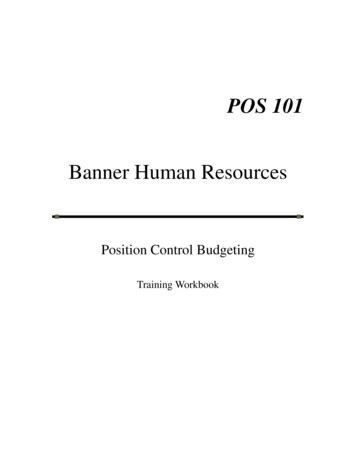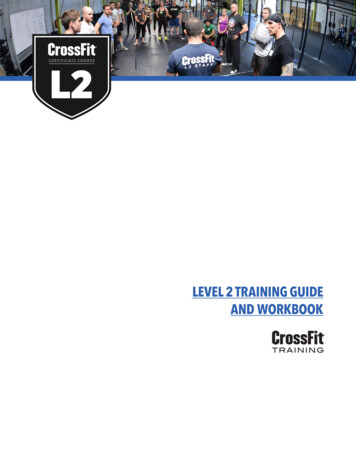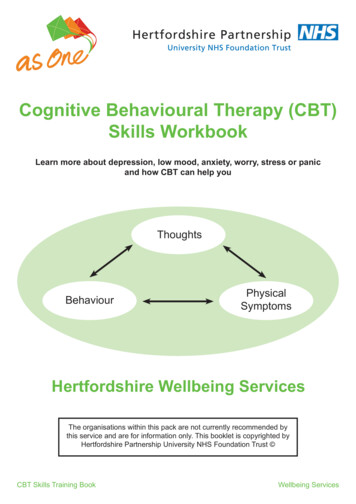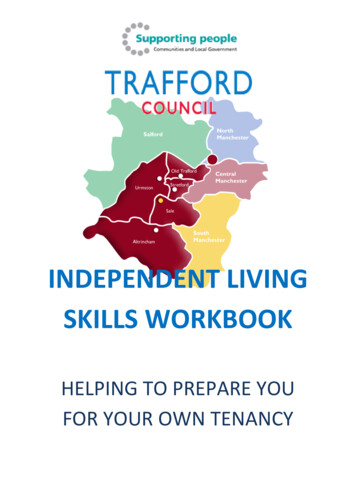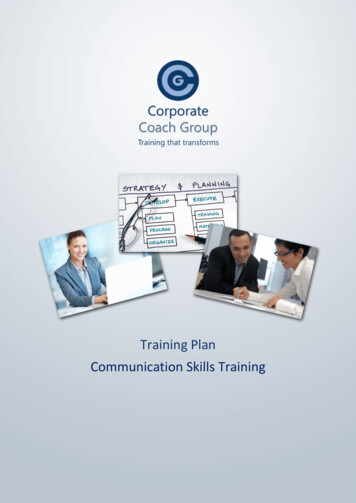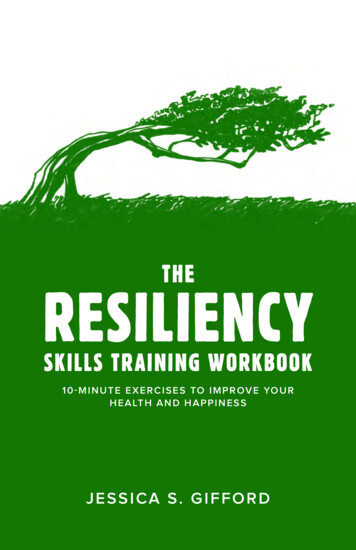
Transcription
THERESILIENCYSKILLS TRAINING WORKBOOK1 0 - M I N U T E E X E R C I S E S TO I M P R OV E YO U RH E A LT H A N D H A P P I N E S SJESSICA S. GIFFORD
The Resiliency Skills Training Workbook10-minute exercises to improve your health and happiness 2020 Jessica GiffordThrive: growing wellness, Northampton MassachusettsAll rights reserved. No part of this publication may be reproduced, distributed, ortransmitted in any form or by any means, including photocopying, recording, or otherelectronic or mechanical methods, without the prior written permission of the author.Cover and interior design by Isaiah King Design, ikingdesign.comThis title may be purchased in bulk for educational or business purposes. Forinformation, please email jessica@growingwellness.lifePrinted in the United States of AmericaISBN 9798624639270First Printing March 2020www.growingwellness.life
The Resiliency Skills Training Workbook10-MINUTE EXERCISES TO IMPROVE YOUR HEALTH AND HAPPINESS
Hello, and welcome to the Resiliency Skills Training (ReST) !This workbook contains a careful selection of exercises and writingprompts that have been shown to build resilience, which in turn willstrengthen relationships, deepen sense of meaning and purpose, andhelp you cope with stressors and challenges.
Table of ContentsHow to Use this Workbookp. 1Assess Your Progressp. 2Why it Works and What to Expectp. 4Think Big: Larger-Than-Self Purposep. 5My Motivationp. 9Week 1: Menu of Activitiesp. 101. Set a Mini Goalp. 122. Emotional Skills: Noting Practicep. 153. Social Connection: Smile!p. 184. Health: Improve Your Sleepp. 215. Meaning: Spend Time in Naturep. 246. Self-Talk: Find a Positive Voicep. 267: Check-inp. 29Week 2: Menu of Activitiesp. 301. Set a Mini Goalp. 322. Emotional Skills: What Went Well, and Whyp. 353. Social Connection: Acts of Kindnessp. 384. Health: Exercisep. 415. Meaning: Explore Your Valuesp. 446. Self-Talk: Write Yourself a Letterp. 507: Check-inp. 56
Week 3: Menu of Activitiesp. 581. Set a Mini Goalp. 602. Emotional Skills: Give Yourself a Breakp. 633. Social Connection: Really Listenp. 664. Health: Get in Touchp. 695. Meaning: Explore/Affirm Your Beliefsp. 726. Self-Talk for Stressful Situationsp. 767: Check-inp. 79Week 4: Menu of Activitiesp. 801. Set a Mini Goalp. 822. Emotional Skills: Watch Your Mental Dietp. 853. Social Connection: Express Appreciationp. 884. Health: Breathep. 925. Meaning: Benefit-Findingp. 946. Self-Talk: Create an Effective Affirmationp. 987: Check-inp. 101Assess Your Progress!p. 102Track Your Activities!p. 106Notesp. 116Acknowledgementsp. 122Endnotesp. 123
How To Use This WorkbookThere are many effective routes to achieving greater mental health andwell-being and creating a fulfilling life. This workbook is intended to helpyou find what works best for you, and provide you with a broad repertoireof practices that you can integrate into your daily routine or turn towhenever you need them.The workbook starts with a couple of foundational activities to set youup for success. The remainder of the workbook is divided into weeks,with 6 activities per week, followed by a reflection. If you like, you can gothrough the workbook sequentially and practice one new activity perday. Or, you may choose to focus exclusively on one activity, and practiceit throughout the week, or anything in between. Remember, the mosteffective activities are the ones that you actually do, so please chooseactivities that match your needs and interests, and are appealing to you.There are several ways to increase your chances of following throughand completing the activities. You’ll notice we ask a series of questionsafter each activity, about why you chose it, what obstacles you anticipate,and how you’ll overcome them. These may feel a bit repetitive, but themore you mentally plan the exercise and how to address obstacles, thebetter your chances of following through, and the more benefit you’llget.1,2 It also helps to establish a habit of wellness. You can help facilitatethis by scheduling a consistent “wellness time” to use this workbookand plan your activities, such as every night before bed, or everyMonday, Wednesday, Friday morning before breakfast.This workbook is for you alone. While you are writing, do not worryabout grammar, sentence structure, or even making sense. Try to writefreely, without censoring your thoughts. There are a number of blankpages at the end of the workbook that you may use to repeat anexercise, make notes, or write about anything you like.If you are interested in facilitating a group, which can provide increasedsupport, connection and accountability, you may download a free facilitator’sguide from my website growingwellness.life. This contains a curriculum fora 4-session group, as well as instructions on how to implement an onlinewellness program.I hope you enjoy The Resiliency Skills Training Workbook!Be well,Jessica GiffordIntroduction1
Assess Your Progress!Making progress in an area that’s important to you can help reinforcethe positive steps you took to make those changes. Is there a particulararea that you’d like to assess your progress, from before to aftercompleting the ReST Workbook? For example, you could measurechanges in the following areas:- Over the last 2 weeks on average, how would you rate your level ofstress or overwhelm?- Over the last 2 weeks on average, how satisfied are you feeling withyour life?- Over the last 2 weeks on average, how capable do you feel abouthandling challenges and meeting your goals?1. What do you hope might change or improve over the next 4 weeks?Please write a question, or an area you’d like to assess here:Averaging over the last 2 weeks, please circle where you fall on a scaleof 1-10 (with 1 being the lowest possible and 10 being the highest possible)234567891012. Is there another area you’d like to assess?Averaging over the last 2 weeks, please circle where you fall on a scaleof 1-10 (with 1 being the lowest possible and 10 being the highest possible)123456789102ReST: The Resiliency Skills Training Workbook
3. Is there a third area you’d like to assess?4. Averaging over the last 2 weeks, please circle where you fall on ascale of 1-10 (with 1 being the lowest possible and 10 being thehighest possible)12345678910Introduction3
Why it Works and What to ExpectThe ReST Workbook is based on the simple premise that increasing yourengagement in wellness-promoting activities will increase your wellbeing and capacity to thrive. The activities in this workbook have beenselected because they have demonstrated effectiveness in:- Improving physical and emotional health- Strengthening relationships and social connection- Reducing stress, anxiety and depression- Increasing academic and work performance, productivity and goalachievement- Managing stress and difficultyAdvances in neuroscience research have demonstrated that the brain is“plastic,” or changeable throughout the lifespan. Your thoughts andactions influence brain chemistry and create neural pathways, which inturn affect your mood and behavior.3,4,5 By engaging in the activities inthis workbook, you are building neural pathways that promote health,happiness and resilience. Brain training, like all training, requires effortand repetition over time, until the neural pathways created by healthyactivities and thought patterns, become well-established and habitual.Brain plasticity research proves that you have the power to change atany time--who you are today is not the same person you will be in thefuture.3,4,5 The exercises in this workbook are designed to help youbecome your healthiest, happiest, most awesome self.Engaging in the activities in this book is like a fitness program for yourbrain, helping it become stronger, healthier and more resilient. You mayexperience benefits immediately, or the effects may be subtle and occurover time. It may be helpful to remind yourself that, even if the results arenot immediately noticeable, you are building new neural networks forpositivity, and encourage yourself to keep going.5 As with a new exerciseroutine, there can be some short term aches and pains for long termgains. Some of the exercises may stir up some difficult, uncomfortable orpainful emotions. This is an important part of the process, and will passin time. If you feel you need additional support at any time, please reachout to friends, meet with a therapist, or connect with other resources.4ReST: The Resiliency Skills Training Workbook
Think Big: Larger-than-self purposeReflecting on what is meaningful and important to you, beyond personalgain, helps you persist in working toward your goals, even when thingsget difficult. This exercise, based on research by Dr. Jennifer Crocker,starts out the workbook in order to help you stay connected to why youare working on wellness, and to help you maintain motivation throughthe full 4 weeks.Benef itsReflecting on the kind of impact you want to have on others or the worldhas been shown to:6,7,8- Deepen sense of meaning and purpose- Create greater calmness and well-being- Decrease depression and anxiety- Improve academic and work performance- Strengthen social connections- Increase persistence toward goals and through difficult tasksPlease write freely for 10-20 minutes in response to these prompts:Purpose is not something you need to “find” or “discover” — it issomething you can create anytime, and change whenever you want to.Please describe the kind of impact you hope to have on others, or onsociety in general, in the future.Introduction5
6ReST: The Resiliency Skills Training Workbook
What skills or qualities do you need to develop in order to have this kindof impact?Introduction7
How will using this workbook and improving your well-being help you tobecome the kind of person you want to be, and have the kind of impactthat you want to have?8ReST: The Resiliency Skills Training Workbook
My motivationThere are always going to be times when your motivation fades—you’retired, busy, or not in the mood. The times when you most want to let selfcare slip are often the times when you need it the most. Please create a1-sentence personal motivation statement that captures why wellness isimportant to you, and what you hope to get out of finishing this workbook.It can be a condensed version of the Larger-Than-Self Purpose exercise,or anything else that you think will motivate you. You may read thisstatement daily, or to refer to it when your motivation is wobbling.My motivational statement:Introduction9
WEEK 1
Week 1Menu of ActivitiesPlease look through the descriptions of activities 1 through 6 on thefollowing pages, choose which one(s) you would like to do this week,and write them down. You may choose 1 activity to do multiple timesthis week, or choose multiple activities to do once each. To get themost benefit, aim to practice some kind of wellness activity at least 3times this week, in addition to what you already do.1. Set a Mini Goal2. Emotional Skills: Noting Practice3. Social Connection: Smile!4. Health: Improve Your Sleep5. Meaning: Spend Time in Nature6. Self-Talk: Find a Positive Voice7. Check-inWhat activity/activities do you plan to do this week?1.2.3.When will you do them? Hint: adding goals to your calendar, or schedulingreminders, significantly improves your chances of following through.1.2.3.Week 111
1Set a Mini GoalThis activity involves setting a small goal that can be accomplishedwithin half an hour or less, that you can do today, or within the week.Use whenYou feel overwhelmed, or want a sense of accomplishmentand competence.Benef its 1,2- Helps generate movement and momentum- Reduces inertia, anxiety and depression- Provides a sense of control and accomplishment- Prioritizes what is important to youWhy it WorksSetting goals prioritizes what is important to you, generates action, andengages your pre-frontal cortex, all of which work to reduce anxiety anddepression. Because mini-goals are small, they are easy to achieve, andbuild your sense of competence and control. Accomplishing a goaltriggers a burst of dopamine, which generates positive emotion andreinforces forward momentum.312ReST: The Resiliency Skills Training Workbook
InstructionsPlease identify one thing that you would like to do today, or within theweek, that can be completed in 30 minutes or less. If you have a largergoal in mind, break it down into small steps and choose one to work on.Ideas for mini-goals include:- Making time for a self-care activity- Completing an item on your To Do list- Connecting with someone you’ve lost touch with- Tackling a minor task you’ve been procrastinating- Doing something funPlease describe your mini-goal:What made you choose this particular goal? How do you think completingit might benefit yourself and others?When will you do it?What might make it difficult to follow through on this goal?Week 113
What can you do to overcome these obstacles?Notes. After you’ve done your mini-goal, take a moment to reflect onhow it feels to have completed it.Is this a practice you’d like to continue? Why or why not?14ReST: The Resiliency Skills Training Workbook
2Emotional Skills: Mindful Noting PracticeThis practice narrating your thoughts and emotions,particularly during times of stress or distress.Use when- You have an “Oh # % &*!!!!” moment, or are in the throes of astress response- You experience painful or difficult emotions- You have negative thoughts (self-criticism, judgment, hopelessness)Benef its- Improves mood, decreases anxiety and depression.4,5- Speeds up recovery from stress, helps you handle conflict andcrises more effectively, improves focus and productivity.6Why it WorksNoting practice works by activating the prefrontal cortex and quietingthe amygdala (where the fight or flight response takes place). Researchhas shown that how you respond to difficult thoughts and emotions hasfar greater impact on mood and well-being than the original thoughtsand emotions themselves.5,7,8 In other words, instead of trying to changehow you think and feel about something, it is far more effective tochange your “meta” response, or what you think and feel about whatyou’re thinking and feeling.Week 115
Stressor or trigger – can’t changePrimary response: what you thinkand feel in response to stressorSecondary or “meta” response:what you think and feel aboutwhat you think and feel – work toaccept, “note” and becompassionate about yourprimary response, rather thanjudging, suppressing, or trying tochange it.InstructionsPractice the following steps (NAN) several times throughout the day, orwhenever you’re experiencing difficult thoughts or emotions.1. Notice: as soon as you notice you are having negative thoughts, or anegative emotional reaction, take a deep breath, and bring yourattention to what you are thinking and feeling.2. Accept: rather than ignoring, resisting or otherwise trying to changeyour thoughts and emotions, accept them.3. Narrate: name whatever you are thinking and feeling, “noting” yourexperience to yourself, e.g. “You’re feeling tense and angry andyou’re thinking this isn’t fair.” If it’s helpful, you can imagine acompassionate observer in the role of narrator.Take a moment to practice now. Please Notice, Accept and Narrate(NAN), in writing, what you are currently thinking and feeling.Please write a couple sentences about why you’ve chosen this activity.How do you think it might benefit yourself and others?16ReST: The Resiliency Skills Training Workbook
What might make it difficult to practice Noticing, Accepting and Narrating(NAN) when you are in the grasp of difficult thoughts or emotions?How can you overcome these obstacles and remember to practice NAN?Notes. After you’ve practiced NAN a few times, please write what you’venoticed. Was it hard or easy to practice? Did you notice any shift inmood, attitude, or actions?Is this a practice you’d like to continue? Why or why not?Week 117
3Social Connection: Smile !This practice involves smiling, greeting, and conveying warmthand friendliness to the people you interact with.Use WhenYou want to give yourself and others a mood boost, and improve socialconnection.Benef its 9- Generates positive emotions in yourself and those around you- Reduces stress- Improves social connection (people who smile are thought to bemore likable and friendly)Why it WorksYou smile more when you’re in a good mood, but smiling can also giveyou a mood boost. It activates neuropeptides, which reduce stress, andtriggers the release of the neurotransmitters dopamine, endorphins andserotonin, which give your mood a lift. Thanks to mirror neurons, smilingis contagious and boosts the mood of those around you as well. Smilingis also the universal sign of friendliness; when you smile you’re viewedas more attractive, reliable, relaxed, likable and sincere.918ReST: The Resiliency Skills Training Workbook
InstructionsSmile, nod and make eye contact with people as you walk by. Smile andgreet people as you enter a room or conversation–focus on beinghappy to see them. Smile and practice conveying warmth and friendlinessas you interact with others.Please write a couple sentences about why you’ve chosen this activity.How do you think it might benefit yourself and others?When will you do this? Please choose a specific day or days to practice.Are there any obstacles that could get in the way of practicing smilingand conveying warmth?What ideas do you have to overcome these obstacles?Week 119
Notes. After you’ve practiced this activity a few times, take a moment towrite what you’ve noticed. How did you like this activity? Did you noticeany shift in your mood, or how other people responded to you?Is this a practice you’d like to continue? Why or why not?20ReST: The Resiliency Skills Training Workbook
4Health: Improve Your SleepThis activity involves engaging in one or two strategies toimprove the quality and/or quantity of your sleep.Use when- You have difficulty falling asleep or staying asleep,- You often feel tired, and want to sleep better- You want to improve your health, mood, attention and performanceBenef itsDeveloping healthy sleep habits can have a dramatic impact on yourwell-being. Improving sleep: 10,11,12- Alleviates stress, depression, and anxiety- Improves attention, memory, and academic performance- Raises mood, motivation, optimism, energy and sociability- Improves physical health: reduces cravings for food and substances,strengthens the immune system, accelerates recovery from injuryand illness, and reduces risk for a number of chronic diseasesWeek 121
Why it WorksSleep is essential to physical and emotional health. Poor sleep has beenfound to be a cause, as well as a symptom, of mental disorders. Thereare 5 stages of sleep, lasting 60-110 minutes each, that you need tocycle through several times a night for optimal benefit. Interruptions tothe cycle cause you to start over. The first 4 stages are “quiet,”increasingly deep sleep, the last of which produces physiologicalchanges that help promote healing and boost the immune system. Thefifth stage is REM sleep, where dreaming occurs. REM sleep enhanceslearning and memory, and contributes to emotional health. Sleepreplenishes your physical, cognitive and emotional resources. Onestudy found that sleep was the strongest predictor of mental resiliencein repatriated prisoners of war.13InstructionsPlease choose one or two of the sleep strategies below to practice.- Give your bedroom a sleep makeover. De-light the space, bycovering all light sources, from windows to electronics, and/orwearing an eye mask to block out light. Reduce irregular sounds byusing earplugs, a white noise machine, or reducing sound in theenvironment. Keep the temperature slightly cool at night. Treatyourself to comfortable sleepwear and pillows.- Develop a sleep routine. Try to go to bed and get up at approximatelythe same time each day, even on weekends, and go through thesame ritual each night, for example: brush teeth, get into pajamas,and read for 15 minutes.- Unwind. If racing thoughts keep you up, try practicing a “minddump” each night by jotting down your worries and unfinished tasksbefore going to bed. Alternatively, find an activity that helps yourelax, such as crossword puzzles, meditation, or journaling.- Avoid PM stimulants. Try to keep stimulants to the morning and earlyafternoon. This includes caffeine, nicotine, vigorous exercise, brightlight, and adrenaline-inducing shows.- Regulate your biological clock. Get outside in the morning for somedaylight. If you can’t do that, expose yourself to bright light in themorning, and dim, yellow-toned light in the evening.22ReST: The Resiliency Skills Training Workbook
Please write a couple sentences about why you’ve chosen this activity.How do you think it might benefit yourself and others?Which sleep strategies will you try, and when will you do them?Are there any obstacles that could get in the way of practicing goodsleep habits?How will you overcome these obstacles?Notes. After you’ve worked on improving your sleep habits, take amoment to write what you’ve noticed. How easy or hard was it toimplement this activity? Did you notice any improvement in the quality orquantity of your sleep? What impact did it have on your mood, energy,focus, interactions, etc?Is this a practice you’d like to continue? Why or why not?Week 123
5Meaning: Spend Time in NatureThis strategy involves spending time outdoors, in a natural setting.Use whenYou feel stressed, mentally cluttered or drained, or anytime you want tounwind and recharge.Benef itsSpending time in nature: 14,15,16,17- Helps you connect to something larger than yourself- Improves attention and restores mental energy,- Relieves stress- Reduces depression, anxiety and ADHD symptoms- Boosts the immune systemWhy it worksNature works primarily by lowering stress. Physiological measurements ofstress hormones, respiration, heart rate, and sweating indicate that evena short amount of time outdoors is calming and sharpens performance.14A study in Japan found that a 15-minute walk in the woods led to a 16%decrease in the stress hormone cortisol, a 2% drop in blood pressure, and a4% drop in heart rate.18 Even a view of nature, or looking at pictures of naturallandscapes, has a positive effect. People with a window view of trees andgrass have been shown to recover faster in hospitals, perform better inschool, and display less violent behavior.14,1924ReST: The Resiliency Skills Training Workbook
InstructionsGet outside and spend 20 minutes in a natural setting. Leave yourphone behind, and really take in your surroundings. Spend a minute ortwo paying attention to each of your senses.Please write a couple sentences about why you’ve chosen this activity.How do you think it might benefit yourself and others?When will you do it?What obstacles might come up to make it difficult to get outside?How will you overcome these obstacles?Notes. After you’ve spent some time in nature, please take a moment toreflect on what you noticed. Did it have an impact on your mood,attitude, or actions?Is this a practice you’d like to continue? Why or why not?Week 125
6Self-Talk: Find a Positive VoiceThis activity involves identifying a kind, compassionate perspective orvoice, in order to shift from negative to more positive self-talk.Use WhenYou want to engage in self-talk that lifts you up and helps you becomeyour best self.Benef itsPositive self-talk:7,8- Improves mood and well-being- Promotes positive self-image- Helps you achieve your goals- Enhances performanceWhy it WorksSelf-talk reflects the stories you tell yourself about who you are, and howyou should, or shouldn’t, behave. It serves to explain or make sense ofother people, events, and the world. How you make meaning out ofwhat happens in your life dictates your emotional response, and ofteninfluences your actions.20 Learning to talk to yourself in ways that aresupportive and encouraging, rather than critical or demeaning, has anenormous impact on your well-being and your personal and professionalsuccess.8 This practice, of identifying the source of a positive voice outsideof yourself, side-steps your own perspective on yourself, which can beslow to change.26ReST: The Resiliency Skills Training Workbook
InstructionsPlease take a few moments to reflect on a positive, supportive,compassionate and encouraging voice for yourself. This could be:- A friend, relative or mentor who consistently sees the best in you- A real life inspirational figure whom you respect and admire, whetheralive or deceased- An imaginary or mythical figure, such as a spirit guide, a superhero,or the character of a book or moviePlease describe the owner of the positive voice in as much detail as youcan. Who are they? What are they like?What is it about this person (or being) that makes you trust them to besupportive, caring, and to always have your best interests at heart?Over the next few days, practice bringing this voice to mind wheneveryou feel stressed, down on yourself, or are struggling with something, andthink about what they would tell you in this situation.Please write a couple sentences about why you’ve chosen this activity.How do you think it might benefit yourself and others?Week 127
How will you remember to access this positive voice when you need itthe most?What obstacles might come up to make it difficult to access thispositive voice?What can you do to overcome these obstacles?When you’ve practiced using this positive voice a few times, please takea moment to reflect on what you’ve noticed. How does it feel to talk toyourself in this way? What impact has it had on your mood, how you seeyourself, and how you respond to difficulty?Is this a practice you’d like to continue? Why or why not?28ReST: The Resiliency Skills Training Workbook
7Check-inCongratulations on completing the first week of yourReST Workbook! Please take a moment to check-in with yourself abouthow you’re doing, what you’ve learned, andwhere you want to go from here.How are you doing right now?What have you noticed from week 1? Please describe what you’velearned, any progress you’ve made, or any changes you’ve noticedover the course of the week.What you would like to remember, or remind yourself of, in theupcoming week?Week 129
WEEK 2
Week 2Menu of ActivitiesPlease look through the activities, choose which one(s) you would liketo do this week, and write them down. You may choose 1 activity to domultiple times this week, or choose multiple activities to do once each.To get the most benefit, aim to practice some kind of wellness activityat least 3 times this week, in addition to what you already do.1. Set a Mini Goal2. Emotional Skills: What Went Well, and Why3. Social Connection: Acts of Kindness4. Health: Exercise5. Meaning: Explore Your Values6. Self-Talk: Write Yourself a Letter7. Check-inWhat activity/activities do you plan to do this week?1.2.3.When will you do them?1.2.3.Week 231
1Set a Mini GoalThis activity involves setting a small goal that can be accomplishedwithin half an hour or less, that you can do today, or within the week.Use whenYou feel overwhelmed, or want a sense of accomplishment andcompetence.Benef its 1,2- Helps generate movement and momentum- Reduces inertia, anxiety and depression- Provides a sense of control and accomplishment- Prioritizes what is important to youWhy it WorksSetting goals prioritizes what is important to you, generates action, andengages your pre-frontal cortex, all of which work to reduce anxiety anddepression. Because mini-goals are small, they are easy to achieve, andbuild your sense of competence and control. Accomplishing a goaltriggers a burst of dopamine, which generates positive emotion andreinforces forward momentum.332ReST: The Resiliency Skills Training Workbook
InstructionsPlease identify one thing that you would like to do today, or within theweek, that can be completed in 30 minutes or less. If you have a largergoal in mind, break it down into small steps and choose one to work on.Ideas for mini-goals include:- Making time for a self-care activity- Completing an item on your To Do list- Connecting with someone you’ve lost touch with- Tackling a minor task you’ve been procrastinating- Doing something funPlease describe your mini-goal:What made you choose this particular goal? How do you think completingit might benefit yourself and others?When will you do it?What might make it difficult to follow through on your mini goal?Week 233
What can you do to overcome these obstacles?Notes. After you’ve done your mini-goal, take a moment to reflect onhow it feels to have completed it.Is this a practice you’d like to continue? Why or why not?34ReST: The Resiliency Skills Training Workbook
2Emotional Skills: What Went Well and Why ?This practice, developed by Dr. Martin Seligman, involvesspending a few minutes reflecting on what went well duringthe day, and why it went well.Use WhenYou want to improve your mood, increase your sense of agency, andtrain your mind to notice the positive.Benef itsThis practice has been shown to:4-7- Improve physical health and reduce aches and pains- Increase happiness and reduce depression- Improve sleep- Help you recognize the role you play in things going well- Improve relationships, and academic and professional successWhy it WorksReflecting on what went well works by bringing the positive things thatare happening in your life into focus, counteracting the natural humantendency to zero in on what went wrong, or what you’re anxious about.Practicing this exercise corrects this negative skew, and helps reducestress, anxiety, and depression and generate feelings of gratitude, calmand confidence. Over time, you will start to automatically seek out thegood, creating an upward spiral of positive emotion.4-7Week 235
InstructionsPlease spend
2. Emotional Skills: Watch Your Mental Diet p. 85 3. Social Connection: Express Appreciation p. 88 4. Health: Breathe p. 92 5. Meaning: Benefit-Finding p. 94 6. Self-Talk: Create an Effective Affirmation p. 98 7: Check-in p. 101 Assess Your Progress! p. 102 Track Your Activities! p.







